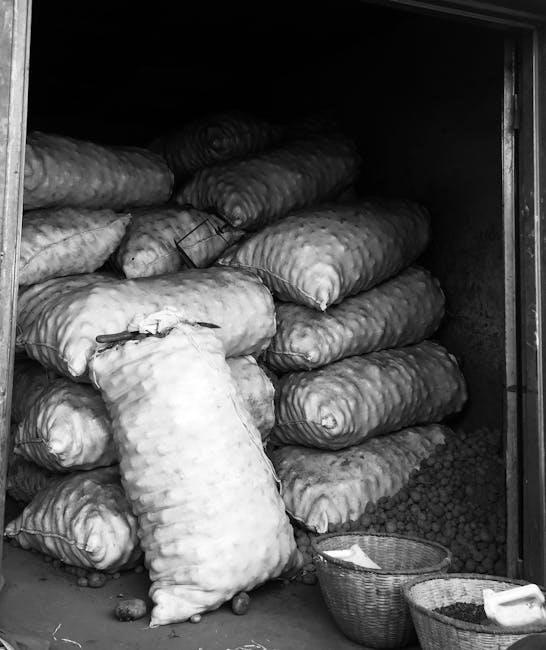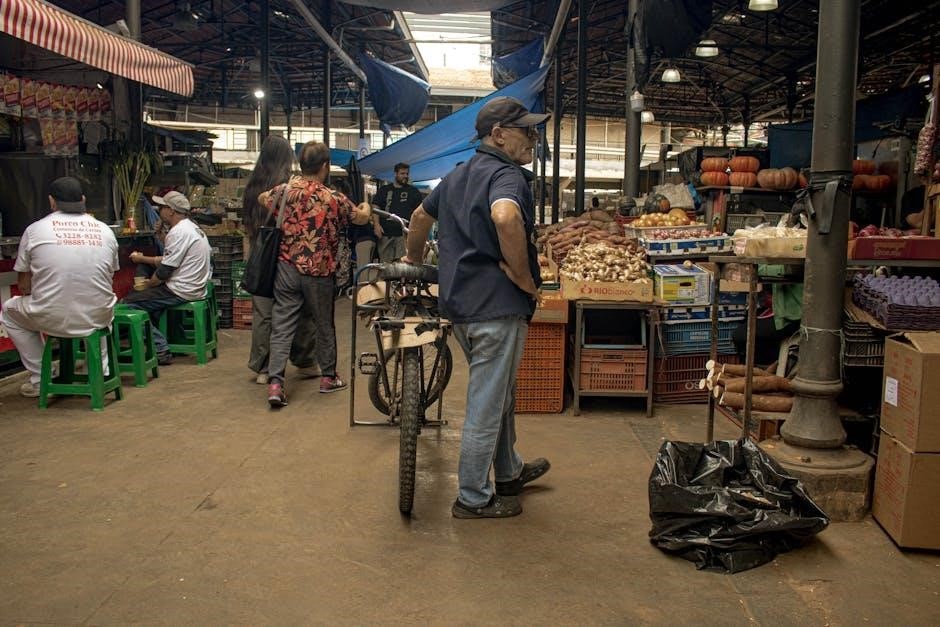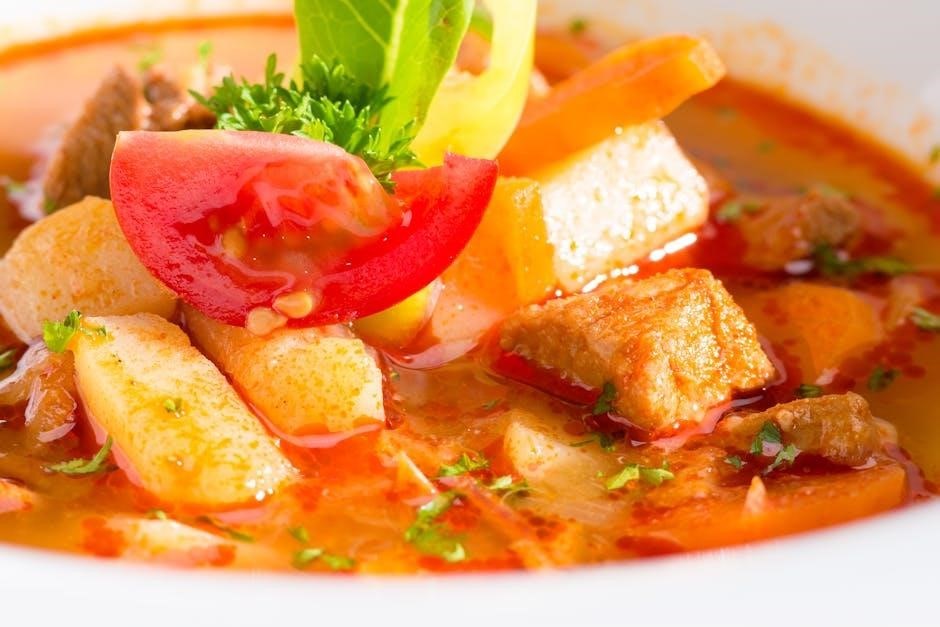
potato bag instructions
Potato bags are convenient kitchen tools designed for cooking potatoes and other vegetables in the microwave. They offer faster cooking times, even results, and are reusable, making them an eco-friendly alternative to traditional methods. Perfect for achieving fluffy, perfectly cooked potatoes in minutes, these bags are a must-have for quick meals.
1.1 What Are Potato Bags?
Potato bags are specially designed kitchen accessories used for cooking potatoes and other vegetables in the microwave. Made from safe, heat-resistant materials like 100% cotton, these bags are designed to trap steam, ensuring even cooking and fluffy results. They are reusable, eco-friendly, and promote faster cooking times compared to traditional methods. Available for purchase or easily made at home, potato bags are a convenient tool for achieving perfectly cooked potatoes without the hassle of boiling or oven baking. Their simple design allows for easy sealing, making them a practical addition to any kitchen for quick, healthy meals.
1.2 The Convenience of Microwave Potato Bags
Microwave potato bags offer unparalleled convenience for home cooks. They allow users to cook potatoes and other vegetables quickly, with minimal effort. Simply place the potatoes inside, seal the bag, and microwave for 4-6 minutes, depending on size. This method eliminates the need for boiling water or preheating an oven, saving time and energy. The bags are also reusable, making them an eco-friendly option. Their compact design ensures even cooking, resulting in fluffy, perfectly cooked potatoes every time. This convenience makes microwave potato bags a must-have for busy households seeking quick, healthy meals without sacrificing taste or texture.

Benefits of Using a Potato Bag
Potato bags offer faster cooking, even results, and a healthier option by retaining nutrients. They are reusable, eco-friendly, and ideal for quick, convenient meals.

2.1 Faster Cooking Times
Microwave potato bags significantly reduce cooking time, delivering perfectly cooked potatoes in just 4-6 minutes. The bag traps heat and moisture, ensuring even cooking. This method is faster than boiling or baking, making it ideal for busy individuals. The quick results are consistent, whether cooking small or large potatoes. The bag’s design allows for efficient microwave use, ensuring potatoes are ready in a fraction of the time compared to traditional methods. This convenience makes it a practical solution for quick meals without compromising on taste or texture.
2.2 Even Cooking Results
Microwave potato bags ensure even cooking results by trapping heat and moisture, which distributes evenly around the potatoes. This eliminates the risk of undercooked or overcooked spots, a common issue with traditional methods. The bag’s design promotes uniform heat circulation, guaranteeing fluffy interiors and tender skins every time. Unlike boiling or baking, where potatoes can vary in doneness, the bag’s enclosed environment ensures consistency. This makes it ideal for achieving perfectly cooked potatoes without constant monitoring. The even cooking results are a testament to the bag’s effectiveness, providing reliable outcomes for home cooks and professionals alike.
2.3 Healthier Cooking Option
Microwave potato bags offer a healthier cooking option by reducing the need for oil or butter, making them ideal for low-fat diets. The bag’s enclosed environment allows potatoes to steam naturally, retaining nutrients and flavor without added fats. This method also minimizes the loss of water-soluble vitamins, preserving the potatoes’ natural goodness. Additionally, the quick cooking time ensures that delicate nutrients aren’t overcooked away. This makes microwave potato bags a great choice for health-conscious individuals seeking a balanced and nutritious meal. The simplicity of the process also encourages the use of fresh, wholesome ingredients, further enhancing the health benefits of this cooking method.

2.4 Reusable and Eco-Friendly
Potato bags are reusable, making them an eco-friendly alternative to disposable cooking methods. Made from durable, food-safe materials like 100% cotton, they can withstand repeated use without losing their effectiveness. This reusability reduces kitchen waste and minimizes the environmental impact of single-use products. Additionally, microwave potato bags promote energy efficiency by cooking potatoes quickly, using less energy than traditional oven or boiling methods. Their long-lasting design and eco-conscious benefits make them a sustainable choice for home cooks. By investing in a reusable potato bag, you contribute to a greener kitchen while enjoying perfectly cooked potatoes every time.
How to Use a Potato Bag
Using a potato bag is simple: wash and dry potatoes, place them inside, seal the bag, and microwave on high for 4-6 minutes, depending on size.
3.1 Step-by-Step Instructions for Cooking Potatoes
Cooking potatoes with a microwave bag is simple and efficient. Start by washing and drying the potatoes thoroughly. Place them inside the bag, ensuring they fit comfortably. Fold the top of the bag to seal in heat. Microwave on high for 4-6 minutes, depending on potato size. After cooking, carefully remove the bag and let it cool slightly. Check for doneness by gently squeezing the potatoes; they should feel soft. If needed, return to the microwave for additional time. This method ensures perfectly cooked, fluffy potatoes every time, making it ideal for quick meals or side dishes.
3.2 Recommended Cooking Times Based on Potato Size
Cooking times in a potato bag vary based on potato size. Small potatoes typically require 4 minutes, while medium-sized potatoes need 5 minutes. Larger potatoes may need up to 6 minutes. Ensure the potatoes are evenly sized for consistent cooking. If cooking multiple potatoes, adjust the time slightly. Always check for doneness by gently squeezing the potatoes through the bag. If they feel soft, they’re ready. Adjust cooking time as needed for your preference. This method ensures perfectly cooked potatoes every time, whether you prefer them slightly firm or fully tender.
3.3 How to Seal the Bag Properly
To ensure proper sealing, place the potatoes in the center of the bag and fold the top edge over 2-3 times to trap heat and moisture. Make sure the fold is tight and even, with no loose fabric. This creates a steam pocket for even cooking. For a secure seal, press the folded edge firmly. Avoid leaving gaps, as this can allow steam to escape, affecting cooking results. If needed, use a clean, dry edge to help the fold stay in place. Proper sealing is key for achieving fluffy, evenly cooked potatoes every time. Always check the seal before microwaving.
3.4 Tips for Achieving the Perfect Doneness
For perfectly cooked potatoes, ensure they are evenly sized and placed in a single layer in the bag. Cook on high for 4-6 minutes, adjusting based on size. Check doneness by carefully removing the bag and poking a potato with a fork—it should be tender but not mushy. If undercooked, return to the microwave in 30-second increments. For fluffier results, let the potatoes stand in the bag for 1-2 minutes after cooking. Rotate the bag halfway through cooking for even heat distribution. Adjust cooking times for larger or smaller potatoes to achieve your desired level of doneness every time;
DIY: Making Your Own Potato Bag
Create a microwave potato bag with 100% cotton fabric. Follow a simple sewing guide or video tutorial for a reusable, eco-friendly pouch perfect for quick meals.
4.1 Materials Needed for Sewing a Potato Bag
To make a microwave potato bag, you’ll need 100% cotton fabric, as it’s microwave-safe and breathable. Choose a durable, tight-weave cotton to prevent overheating. You’ll also need thread, sewing needles, and scissors. Optional materials include batting for insulation and ribbon or Velcro for closure. Ensure all fabrics and notions are heat-resistant to avoid fire hazards. These materials are readily available at craft stores or online, making the project accessible for sewers of all skill levels. Proper material selection ensures safety and effectiveness when cooking potatoes or other vegetables in the microwave.
4.2 Step-by-Step Sewing Instructions
Begin by cutting two rectangular pieces of 100% cotton fabric to your desired size. Place the fabric pieces right sides together and align the edges. Sew around the perimeter, leaving a small opening to turn the bag right side out. Carefully turn the bag and press the seams with an iron for a crisp finish. Fold the raw edges of the opening under and sew them shut. Topstitch around the bag for added durability. If desired, attach Velcro or a ribbon to create a closure; Ensure all stitching is secure and the bag is free of loose threads. This creates a safe, reusable microwave potato bag.
4.3 Customizing Your Potato Bag
Customize your potato bag to suit your style and needs. Choose vibrant fabrics or patterns for a personalized look. Add a Velcro closure or ribbon tie for easy opening and closing. Incorporate pockets or compartments for organization. Embellish with embroidery, appliques, or quilting for a decorative touch. Consider adding a label or tag for identification. For functionality, include a loop or handle for easy carrying. Ensure all customizations are microwave-safe, avoiding metal elements. Experiment with sizes to accommodate different vegetable quantities. Personalizing your bag makes it unique and tailored to your kitchen preferences, enhancing both utility and aesthetics.

4.4 Troubleshooting Common Sewing Issues
When sewing a potato bag, common issues may arise. If the fabric frays excessively, use a zigzag stitch or serger on raw edges. For uneven seams, adjust your machine tension or use a walking foot. Loose stitches can be tightened by checking thread tension or increasing stitch length. Ensure fabric is pre-washed to prevent shrinkage. If the bag doesn’t seal properly, reinforce the top with additional stitching or a ribbon tie. Avoid using metal fasteners, as they can cause sparks in the microwave. By addressing these issues, you can create a durable, functional, and safe potato bag for years of use.
4.5 Choosing the Right Fabric for Safety
Selecting the right fabric is crucial for a safe and functional potato bag. Opt for 100% cotton or cotton-blend materials, as they are microwave-safe and breathable. Avoid synthetic fabrics like polyester or nylon, as they can melt or catch fire. Ensure the fabric is tightly woven to retain heat but allow steam to escape, preventing overheating. Avoid fabrics with metal threads or embellishments, as they can spark in the microwave. Pre-wash the fabric to remove any finishes and shrink it before sewing. Choosing the right fabric ensures your potato bag is durable, safe, and effective for cooking potatoes and other vegetables.
4.6 Threading and Stitching Tips
For sewing a potato bag, use 100% cotton thread to ensure durability and microwave safety. Choose a needle size 8 or 10 for heavier fabric. Maintain a consistent stitch length for even seams. Use a 1/4-inch seam allowance to ensure the bag is sturdy. Backstitch at the beginning and end of each seam for reinforcement. When sewing the top hem, fold it twice to create a casing for the drawstring. Keep the fabric taut while stitching to avoid puckering. Use a walking foot or Teflon foot for smooth sewing on thick or layered fabric. These tips ensure a professional finish and safe microwave use.
4.7 Video Guide for Visual Learners
A video guide is an excellent resource for visual learners to master sewing a potato bag. These tutorials provide step-by-step demonstrations, making it easier to understand complex techniques. Watch the video before starting your project to familiarize yourself with the process. Pause and rewind as needed to focus on details like threading, stitching, and sealing the bag. Ensure the video is high-quality and includes close-ups of key steps. Follow along with the instructor to practice hands-on. Many guides also include tips for troubleshooting common issues. Referencing a video guide can help you achieve professional results and ensure your potato bag is both functional and safe for microwave use.

Safety Tips and Precautions
Always follow safety guidelines when using a potato bag. Avoid fire hazards, ensure safe microwave use, and prevent overheating. Use microwave-safe materials and follow instructions carefully.
5.1 Avoiding Fire Hazards
To prevent fire hazards, ensure your potato bag is made from microwave-safe, non-flammable materials like 100% cotton. Avoid using synthetic fabrics or metallic accents, as they can ignite. Keep the bag away from direct flames and never leave it unattended while in use. Always follow the recommended cooking times and power levels to avoid overheating. Regularly inspect the bag for wear and tear, and replace it if damaged. By taking these precautions, you can safely enjoy perfectly cooked potatoes without risking a fire incident.
5.2 Ensuring Safe Microwave Use
For safe microwave use, always ensure your potato bag is made from microwave-safe materials, such as 100% cotton, and avoid synthetic fabrics or metallic accents. Never leave the bag unattended while cooking. Follow the recommended cooking times and power levels to prevent overheating. Keep the bag away from direct contact with microwave walls to avoid hot spots. Regularly inspect the bag for signs of wear or damage before use. Proper sealing is essential to maintain even heat distribution. By adhering to these guidelines, you can enjoy safe and efficient cooking with your potato bag.

5.3 Preventing Overheating
To prevent overheating, use microwave-safe materials like 100% cotton and avoid synthetic fabrics or metal accents. Never leave the bag unattended while cooking. Check the bag for wear or damage before use, as holes or frayed edges can cause hot spots. Follow recommended cooking times and power levels to avoid excessive heat buildup. Ensure the bag isn’t overly full, allowing steam to circulate evenly. If you notice the bag overheating, stop the microwave immediately. After cooking, let the bag cool slightly before handling. Proper care and adherence to guidelines will help prevent overheating and extend the bag’s lifespan.

Versatility Beyond Potatoes
Potato bags are versatile kitchen tools that can cook other vegetables like carrots, green beans, and corn. They also work great for reheating meals and steaming veggies efficiently.
6.1 Cooking Other Vegetables in the Bag
Potato bags are not just for potatoes! They can be used to cook a variety of vegetables like carrots, green beans, and corn. Simply place the vegetables inside the bag, seal it, and microwave for 3-5 minutes, depending on the vegetable type and quantity. This method ensures even cooking and retains nutrients. The bag’s design allows steam to circulate, resulting in tender and flavorful vegetables. It’s a great way to prepare healthy, quick side dishes. Experiment with different vegetables and seasonings to enhance your meals. This versatility makes the potato bag a multi-purpose tool for any kitchen.
6.2 Using the Bag for Reheating Food
Potato bags are not only for cooking potatoes but also excel at reheating food. Place leftovers like rice, vegetables, or even cooked meals inside the bag and microwave for 1-3 minutes. The bag retains moisture and heat, ensuring food stays fresh and flavorful. This method is ideal for reviving last night’s dinner without drying it out. Simply seal the bag, microwave, and enjoy. It’s a convenient, mess-free way to reheat meals without using plastic wrap or microwave-safe containers. The bag’s design distributes heat evenly, making it perfect for warming a variety of dishes quickly and efficiently.
Cleaning and Maintenance
Regularly clean your potato bag with mild soap and water. Avoid harsh chemicals or abrasive scrubbers. Air-dry thoroughly to prevent moisture buildup. Machine washing is not recommended.
7.1 How to Clean Your Potato Bag
To maintain your potato bag, clean it after each use with mild soap and warm water. Gently scrub any food residue with a soft sponge or cloth. Avoid using harsh chemicals or abrasive scrubbers, as they may damage the fabric. Rinse thoroughly to remove all soap residue. Do not machine wash or dry the bag, as this could cause shrinkage or damage. Instead, air-dry the bag by laying it flat or hanging it in a well-ventilated area. Regular cleaning prevents bacterial growth and keeps the bag fresh for future use. Cleaning immediately after use helps prevent food from hardening and makes the process easier.
7.2 Maintaining the Bag’s Quality
To maintain your potato bag’s quality, store it in a cool, dry place away from direct sunlight. Avoid leaving the bag damp, as moisture can lead to mildew. After cleaning, ensure the bag is completely dry before storing. Do not fold or crease the bag excessively, as this may weaken the fabric over time. For added protection, you can store it in a breathable cloth or paper bag. Regularly inspect the bag for signs of wear, such as frayed edges or loose stitching, and repair them promptly. Proper care ensures your potato bag remains durable and safe for repeated use.

FAQs About Potato Bags
Common questions include fabric choice, cooking times, and washing methods. Answers provide clarity on safety, durability, and optimal use for microwave cooking and reheating.
8.1 Can I Use Any Fabric for Making a Potato Bag?

Not all fabrics are suitable for making a potato bag. 100% cotton fabric is recommended because it is breathable and can withstand high temperatures without melting or releasing harmful chemicals. Synthetic fabrics like polyester or nylon are not ideal, as they may melt or catch fire when exposed to microwave heat. Always choose a natural, non-synthetic material that is safe for high-temperature use. Ensure the fabric is free from chemical treatments or dyes that could release fumes during cooking. Pre-washing the fabric before sewing is also a good practice to remove any finishes that might affect safety.
8.2 How Long Does It Take to Cook Potatoes in the Bag?
Cooking potatoes in a microwave bag typically takes 4-6 minutes on high, depending on their size. Small to medium-sized potatoes generally require 4-5 minutes, while larger potatoes may need 6-7 minutes. The exact time can vary based on personal preference for doneness and microwave power levels. It’s important to check the potatoes after the recommended time and adjust as needed. Overcooking can lead to dry, unappetizing results, so monitoring the cooking process is key. Always follow the guidelines provided with your potato bag for optimal results and safety.
8.3 Can I Wash the Potato Bag in a Washing Machine?
While it’s possible to wash a potato bag in a washing machine, it’s generally recommended to hand wash it to maintain its quality. If machine washing, use a gentle cycle with cold water and a mild detergent. Place the bag in a mesh laundry bag for added protection. Avoid using fabric softeners or bleach, as they may damage the material. Air drying is advised to prevent shrinkage and ensure the bag retains its shape. Regular cleaning helps maintain hygiene and longevity, making the bag safe for repeated use in cooking potatoes and other vegetables.
Potato bags offer a convenient, efficient, and eco-friendly way to cook potatoes and other vegetables. Whether store-bought or homemade, they ensure perfectly cooked meals with minimal effort and time.
9.1 Final Thoughts on Using and Making Potato Bags
Potato bags are a game-changer for home cooks seeking convenience and efficiency. They simplify meal prep, ensuring perfectly cooked potatoes and vegetables every time. Whether you purchase one or craft your own, these bags are a versatile and eco-friendly addition to your kitchen. The ability to cook in minutes, coupled with their reusability, makes them a practical choice for busy households. Exploring beyond potatoes, they also excel at steaming other veggies and reheating meals. With proper care, a potato bag can become a long-lasting kitchen companion, enhancing your cooking routine while promoting sustainability. Give it a try and enjoy the ease of perfectly cooked meals!